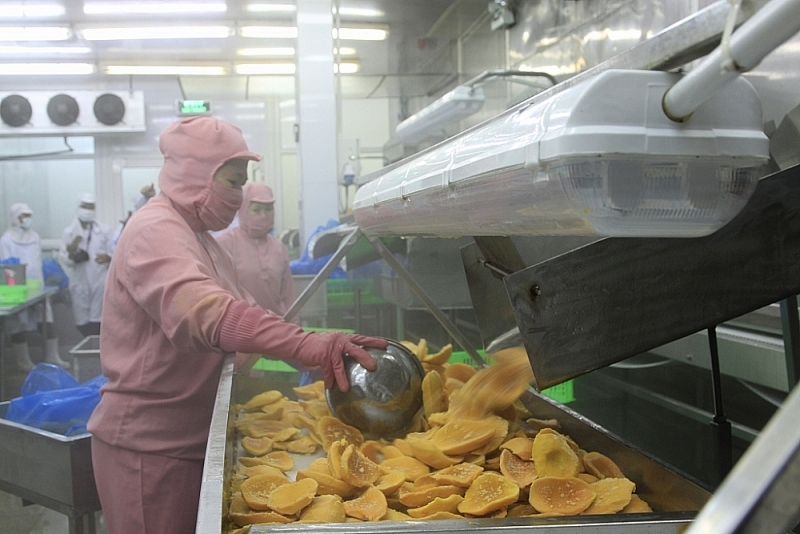VCN – The reopening of China on January 8 is a great opportunity for export businesses after a long time affected by the Covid-19 epidemic. However, China has new regulations on exporting agricultural products that businesses must understand to export smoothly to this market.
According to Mr. To Ngoc Son, Deputy Director of the Asia-Africa Market Department (Ministry of Industry and Trade), China is the most important market and Vietnam’s number one trading partner. Import-export turnover between Vietnam and China in 2022 will reach USD 175.5 billion. The proportion of imports and export with China in Vietnam’s total imports and export accounts for 24%.
Giving the reason why China is an important export market for several Vietnamese agricultural products, the representative of the Ministry of Industry and Trade emphasized that China is the largest export market of vegetables and fruits with a proportion of 53.7%; cassava and cassava products with the proportion of 91.47%; rubber with the proportion of 71%. In addition, China is also the third largest export market of Vietnamese seafood (after the United States and Japan).
Therefore, the fact that China announced the opening of border gates to promote trade in goods, including trade in agricultural products from January 8, is good news for Vietnamese and Chinese businesses to import and export agricultural, forestry and fishery products.
Regarding the export situation to the Chinese market, according to the Deputy Minister of Agriculture and Rural Development, currently, in Lao Cai, there are more than 500 trucks that export agricultural products a day, while in Lang Son, there is an average of 500 vehicles a day. Therefore, more than 800 vehicles were cleared. Thus, vehicle traffic began to increase.
Also, according to Deputy Minister Tran Thanh Nam, over the past time, the Ministry of Agriculture and Rural Development has implemented strong communication of regulations 248 and 249 on registration of import-export enterprises to China and management of safe food. As a result, Chinese Customs has issued 2,492 import-export enterprise codes under Order 248. Furthermore, the Ministry of Agriculture and Rural Development has provided over 2,000 codes for growing areas and 1,438 codes for packing establishments for agricultural products exported to the Chinese market. In addition, the Ministry of Agriculture and Rural Development has strongly implemented the construction of raw material areas to ensure standards for export.
China has recently opened the railway line between Laos and Thailand. Thus, the time to transport goods, including agricultural products, from Thailand to China will be reduced by 1 day, and transportation costs will be reduced by over 20%. This is a problem for exporters, requiring them to improve product quality and design and reduce costs.
 |
| Vietnam, with many agricultural and aquatic products, has advantages when exporting to the Chinese market. Photo: Nguyen Thanh |
According to Mr. To Ngoc Son, one of the solutions to maintain a sustainable export market is that the quality of agricultural products and food must be considered. Therefore, enterprises ensure the strict implementation of Chinese regulations and standards.
In recent years, China has adjusted its policies and regulations towards placing higher requirements on food and agricultural products imported into China. Specifically, after Order 248 and Order 249 in 2022, China has put into practice and implemented Order 259, requiring foreign units and organizations to supervise and certify standards for foreign organizations. As a result, agricultural products and goods of the exporting country must have a registration with the General Administration of Customs of China so that the results of supervision and this certificate can be used when carrying out clearance procedures.
After Order 248 on “Regulations on management of registration of enterprises producing imported foreign food” and Order 249 on “Measures to manage food safety for import and export”, Chinese agricultural exports must comply with the Order. 259, requires foreign units and organizations participating in quality supervision and certification in the exporting country to register with China.
To meet the increasing standards, especially the requirements from Orders 248 and 249, the Deputy Minister of Agriculture and Rural Development requires enterprises to comply with the technical requirements strictly; combine with local agricultural units to build raw material areas; coordinate with the units implementing the issuance of planting area codes, packing facilities to meet your requirements.
Regarding the implementation of linkages, businesses need to actively contact units such as the Border Gate Management Board to obtain information on the progress of customs clearance, avoid congestion, and ensure the quality of agricultural products, the clearance time and transportation costs.
By Xuân Thảo/Bui Diep
